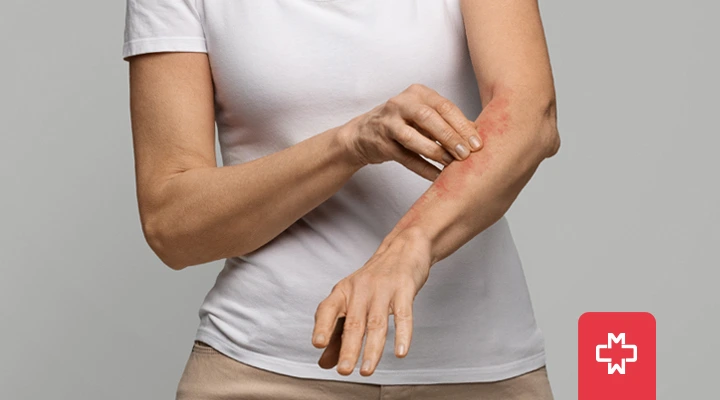Have you ever wondered why a simple bandage could at times turn into your skin’s enemy? – Imagine needing a simple adhesive, and the next thing you know, your skin starts showing signs of not accepting it.
For anyone who has experienced this frustration of itch, redness, and rash from the bandaid that you needed; you should know that it is an allergic contact dermatitis reaction to a bandaid, which makes you a part of the adhesive allergy club – a not-so-interesting club!
But worry no more – with an objective to explain how to treat skin irritation from tape, bandaid allergy, and general allergy to adhesives; Manhattan Medical Arts has brought you a survival guide to help you get through adhesive allergy with ease.
What Is an Adhesive Allergy?
Adhesive allergy, also known as contact dermatitis, can be explained as an immune system response triggered by an allergic reaction to a bandaid, or other adhesives.
Our skin reacts against this allergy to adhesives, causing redness, itching, and other uncomfortable symptoms. This allergic contact dermatitis can affect anyone, and its severity varies from person to person. Symptoms of allergic contact dermatitis can get worse with each exposure, while irritant contact dermatitis symptoms are usually the same intensity every time.
Causes of Adhesive Allergy
To comprehend the mysterious rash from bandaid or other adhesives, let’s first understand the different causes that can trigger an allergy to adhesives, leading your skin to protest and causing discomfort.
Here are all the causes of adhesive allergic reaction:
- Chemical Components: Adhesives are composed of several chemicals. Certain ones such as acrylates and epoxy resins can cause allergic reactions that lead to skin irritation, redness, and itching. Being sensitive to certain chemicals plays a key role in adhesive bandages allergy.
- Latex Allergy: The itch or redness that you feel after using adhesive bandages, it might be latex that causes it. Latex is a natural rubber in some adhesives that can cause skin reactions. Being able to identify and opt for latex-free alternatives is very important for everyone with known latex sensitivities.
- Fragrances and Preservatives: Adhesives often have added fragrances and preservatives. These can trigger allergic responses, causing skin irritation, redness, and itching. Opting for fragrance-free or hypoallergenic adhesives can help those prone to this type of sensitivity.
- Fabric or Material Sensitivity: The toxic or irritating material itself can cause allergic reactions. Adhesive bandages come in various forms, like cloth, paper, or plastic. Some may be sensitive to specific materials, and choosing adhesives made from alternative materials can bring relief.
- Pressure-Sensitive Adhesives: Adhesives in tapes and adhesive bandages apply pressure on the skin. Extended with this contact can lead to reactions, causing red, itchy rashes. Managing this involves choosing adhesives with lower adhesion levels or using protective layers to reduce direct skin contact.
What Does an Adhesive Allergy Look Like?
Adhesive allergy can typically be seen as red, itchy rashes at the site of adhesive contact dermatitis. These rashes can vary in severity and may be accompanied by swelling, blistering, or even oozing at times. Understanding these signs is essential for early identification and successful management of allergy to adhesives.
Adhesive Allergic Reactions Symptoms
Adhesive allergy symptoms can show themselves in various ways – Let’s explore this diverse range of symptoms that might be signaling your skin’s discomfort.
- Itching and Redness: Persistent itching and redness at the adhesive contact site may signal an allergy, surpassing a minor irritation.
- Swelling and Blistering: Band aid adhesive allergy can lead to visible swelling and fluid-filled blisters, intensifying discomfort in severe cases.
- Oozing and Crusting: Intense adhesive reactions may at times cause fluid oozing or a crusted appearance, indicating a pronounced inflammatory response that requires instant medical attention.
- Pain or Discomfort: Adhesive allergies may cause pain or discomfort at the contact site, depending on the reaction’s severity.
- Change in Skin Texture: Adhesive allergy may also change the skin’s texture, causing it to feel rough, scaly, or uneven in comparison to surrounding skin.
- Skin Rash Spreading: Adhesive allergy rashes may spread beyond the initial contact area.
Diagnosing an Adhesive Allergy
The process of diagnosis is quite similar to a detective’s work, as requires piecing together evidence and symptoms to identify the cause of discomfort.
Listed below are the ways to diagnose an adhesive allergy:
- Patch Testing: Small amounts of common allergens, including adhesive components, are applied to patches on the skin. After removal, reactions are examined to pinpoint the specific allergen causing the adverse response.
- Medical History Assessment: Your healthcare provider delves into your medical history, uncovering details about adhesive exposure and previous skin reactions. This thorough assessment establishes a symptom timeline and identifies patterns for a more accurate diagnosis.
- Physical Examination: A detailed examination of the affected skin is crucial for diagnosing adhesive allergies. Healthcare professionals assess the appearance, distribution, and severity of the skin reaction to distinguish it from other dermatological conditions.
- Elimination Test: In some cases, an elimination test involves avoiding the suspected adhesive for a specified period. If symptoms subside, it suggests a potential link between the adhesive and the allergic reaction.
- Photopatch Testing: Photopatch testing assesses if sunlight triggers allergic reactions in individuals experiencing skin issues. This specialized testing explores the combination of adhesive and sunlight as potential allergens.
- Intradermal Testing: Reserved for rare instances, intradermal testing involves injecting small amounts of allergens under the skin to observe the body’s immune response. This method is used when other diagnostic approaches haven’t provided conclusive results.
Adhesive Allergy Treatments
Here’s a range of adhesive allergy treatment options available to help you treat the challenges of skin.
- Avoidance of Allergens: Manage adhesive allergies by avoiding contact with specific allergens. Identify components causing the allergy and choose hypoallergenic or sensitive skin-friendly adhesives to reduce the risk of reactions.
- Topical Steroids: For mild to moderate symptoms, healthcare professionals may recommend topical corticosteroids. These creams or ointments alleviate itching, redness, and swelling, providing relief without systemic treatments.
- Emollients and Moisturizers: Keep affected skin hydrated with emollients to manage adhesive allergy symptoms. These products soothe dryness and reduce irritation, creating a healing environment for affected areas.
- Oral Antihistamines: Alleviate symptoms, such as itching with oral antihistamines. These medications promote better sleep by reducing discomfort. Opt for non-drowsy formulations if alertness is essential during the day.
- Cool Compresses: Provide immediate relief from itching and reduce inflammation by applying cool compresses. Use a clean cloth soaked in cold water on affected areas for soothing short durations.
- Corticosteroid Injections: For severe or widespread symptoms, healthcare professionals may suggest corticosteroid injections. This treatment delivers a potent anti-inflammatory effect directly to the affected area, providing rapid relief.
- Immunomodulators: In certain cases, prescribed immunomodulators like tacrolimus or pimecrolimus help modulate the immune response. Beneficial for managing persistent or recurrent adhesive allergy symptoms, these medications provide targeted relief.
You can get a rash from a band-aid if you’re allergic to latex, rubber, or other adhesive bandage materials. But there are alternative options. Many bandages use adhesives to help them stick to your skin and cover wounds.
When to See a Doctor?
Consult a healthcare professional if you experience persistent or alleviated symptoms, or if you suspect an adhesive allergy or contact dermatitis. Timely medical intervention ensures accurate diagnosis and appropriate management.
Conclusion
In your journey to survive adhesive allergy, knowledge is key. Manhattan Medical Arts is here to support you on this path to wellness. If you suspect an adhesive allergy or need personalized care, our experienced medical team is ready to assist you.
Take charge of your health and enjoy a life free from the constraints of adhesive allergies.
Frequently Asked Questions
Why am I suddenly allergic to bandaids?
Bandaid allergy can develop due to sensitivities to specific adhesive components. Changes in formulations or increased exposure may trigger sudden allergies.
What is the best tape to use on your skin if you are allergic to adhesive?
Hypoallergenic tapes, often labeled as suitable for sensitive skin, are the best choice for individuals allergic to adhesive. Options like silicone-based, paper, or cloth surgical tape are less likely to cause reactions.
What are the common allergens in adhesives?
Common allergens in adhesives include acrylates, latex, fragrances, and preservatives. Identifying specific allergens helps in choosing suitable, hypoallergenic products.
How to treat a rash from bandaid adhesive?
Treat a rash from bandaid adhesive by avoiding further contact, using mild soap and water to cleanse the area, applying a soothing emollient, and, if needed, using over-the-counter corticosteroid creams under medical guidance.
How long does it take for an adhesive allergic reaction to go away?
The duration of an adhesive allergic reaction varies. Mild reactions may resolve in a few days with proper care, while more severe cases may take weeks. Consult a healthcare professional for personalized guidance.
When will I experience allergic contact dermatitis?
You may experience allergic contact dermatitis within hours to a few days after your skin comes into contact with an allergen, such as certain plants, metals, or chemicals, causing redness, itching, skin discoloration, and rash. Allergic contact dermatitis from adhesives is much rarer than irritant contact dermatitis.
What is skin barrier film?
A skin barrier film is a protective layer applied to the skin to shield it from irritants, moisture, and adhesives. It's often used to prevent skin damage in areas prone to friction or exposure.
– Disclaimer –
his blog is for informational & educational purposes only, and does not intend to substitute any professional medical advice or consultation. For any health related concerns, please consult with your physician, or call 911.
-
About The Author
Dr. Syra Hanif M.D.Board Certified Primary Care Physician
Dr. Syra Hanif is a board-certified Primary Care Physician (PCP) dedicated to providing compassionate, patient-centered healthcare.
Read More







